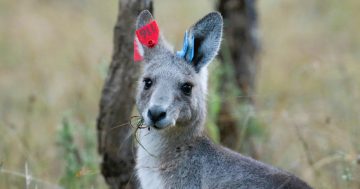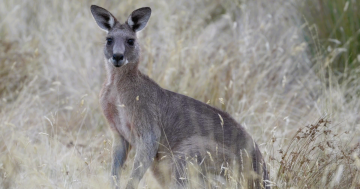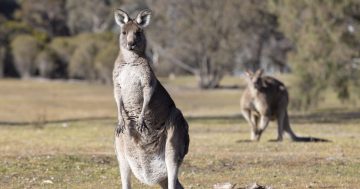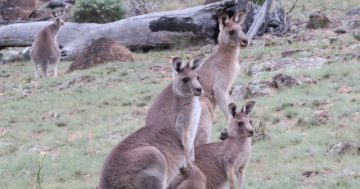
Collared kangaroos prior to GonaCon treatment. Photos: ACT Government.
As the ACT Government announces another kangaroo cull, research into a fertility control method will now be continued and expanded for another two years as it edges closer to providing an alternative to shooting in some areas of Canberra.
The Environment, Planning and Sustainable Development Directorate (EPSDD) has contracted the services of the CSIRO’s Dr Lyn Hinds and staff to support the work of directorate ecologists, which have been trialling the use GonaCon Immunocontraceptive Vaccine delivered by dart gun on Eastern Grey Kangaroos and since 2018 on Rednecked Wallabies (RNWs) in the fenced, predator-free Mulligans Flat Woodlands Sanctuary.
The research is showing promise but further monitoring of its results and refining of the dart delivery is required.
The next phase of the program will also be expanded to Swamp Wallabies at Mulligans Flat and both wallaby species at the newly established Goorooyarroo Sanctuary.
EPSDD ecologist Claire Wimpenny, who has been involved with the program from the beginning in 2015, says that while the research is promising, fertility control won’t completely replace traditional culling methods but it could limit it to the bigger and less accessible sites.
”Using fertility control alone, it will take a really long time for the population to go down,” she said. “The best way to reduce populations is through culling and then to apply fertility control through the females.
”It’s going to be an integrated thing but we imagine it’s going to be really useful as a first step in the small reserves.”
Ms Wimpenny says the trial has shown that GonaCon works as a contraceptive and can be safely and effectively delivered using a dart but researchers don’t know how long it will last.
Studies of hand-injected and dart-delivered animals had produced comparable results but it may be that the lower-impact dart method does not administer the vaccine as effectively.
”After three years, more than 90 per cent in both groups have failed to breed, but it’s important for us to keep monitoring those animals because we don’t know how long the effects will last,” Ms Wimpenny said.
”There’s a possibility with dart delivery that it might not last as long as hand-injected [fertility control].”
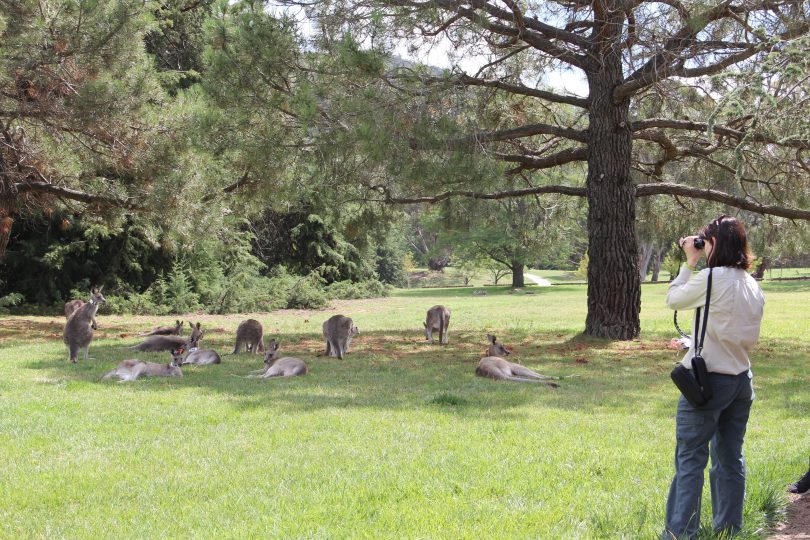
Monitoring kangaroos treated with GonaCon at Weston Park.
Over the next 12 to 18 months researchers will be looking at whether or not it is feasible to start incorporating dart-delivered fertility control into the culling program
Ms Wimpenny says it will also be important to monitor and model populations ”because it’s all well and good to be able to cause infertility in particular individuals but we need to be able to have an impact on the growth of the population as a whole”.
”So we’ve got some populations where we’re treating as many of the females as we can and we’ve seen so far a reduction of the proportion of females produced in those populations each year, which is really promising as well,” she said.
Researchers will also do top-up treatments of any new females that have bred for the first time.
They will also try to extend the distance at which darts can be fired so the method can be used at larger sites, including reducing the weight of the dart so it can be used safely over a longer range.
Researchers use a gas-powered rifle using customised darts and undergo rigorous training before being allowed to use it on live animals, to ensure the method is humane and no injury is caused to a kangaroo.
The dart comes with marking paint that is sprayed on the animal’s fur on impact, and that marking system also needs to be improved so target animals can be seen at longer distances.
Ms Wimpenny says the work also involves a cost-benefit analysis to compare the costs of fertility control and contracting shooters.
”Lethal shooting is cheaper in the short term but what we need to do is build that model up and look at that over the longer term, and we’ve done some preliminary work and it’s looking like over a 20-year period using fertility control would be cheaper than shooting,” she said.












